If you’ve ever wondered what that bird was you saw flitting about your sunflowers or how you can draw more hummingbirds to your backyard, look no further. Here are the 13 birds native to the U.S. and beyond that you’ll most likely see outside, profiled in depth by the Cornell Lab of Ornithology. See what species are already hanging out in your yard, or learn how you can encourage others to visit.
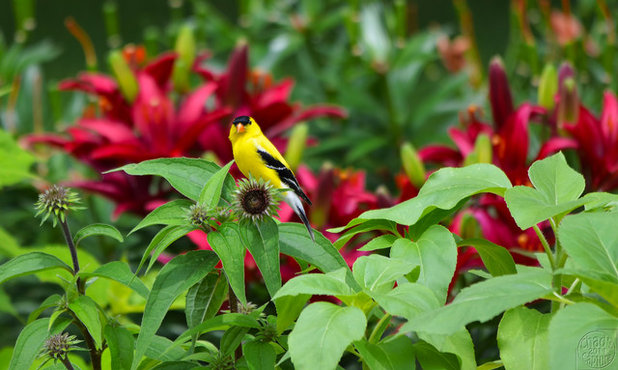
Chad Horwedel
1. American Goldfinch
Where you’ll see them: In more than 30 states from east to west; as far north as southern Canada in summer and the southeastern or southwestern U.S. in winter
When to look: Year-round, although they’re less distinct in winter
Gardens across the U.S. gain an animated, conspicuous visitor in summer, as American goldfinches — the males are the golden ones — dash from seed head to bird feeder in search of rich sustenance.
Unlike most native songbirds, goldfinches are strictly vegetarian, relying primarily on a diet of seeds. Native grasses, sunflowers and noninvasive thistles are great food sources for goldfinches, and feeders filled with sunflower and Nyjer seeds supplement their winter meals. If you do use a feeder, be sure to regularly clean it to prevent house finch eye disease.
Learn more about American goldfinches
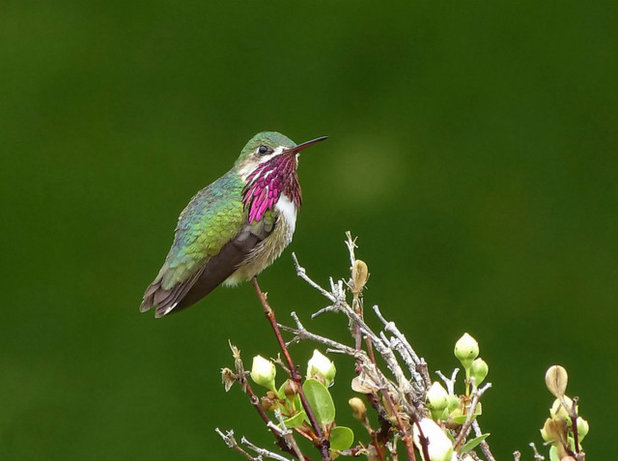
Mike Wisnicki
2. Hummingbirds
Where you’ll see them: Various species in various areas across the country
When to look: Depending on where you live, you’ll see hummingbirds year-round or in the summer.
Only in North American, South American and Central American gardens will you find hummingbirds vigorously flitting about, with over a dozen species calling North America home.
These tiny backyard visitors rely on a nectar-rich diet, so plant flowering natives that produce nectar and support native insects. Clean, full and simple feeders are also welcome food sources for backyard hummingbirds.
Learn more about hummingbirds
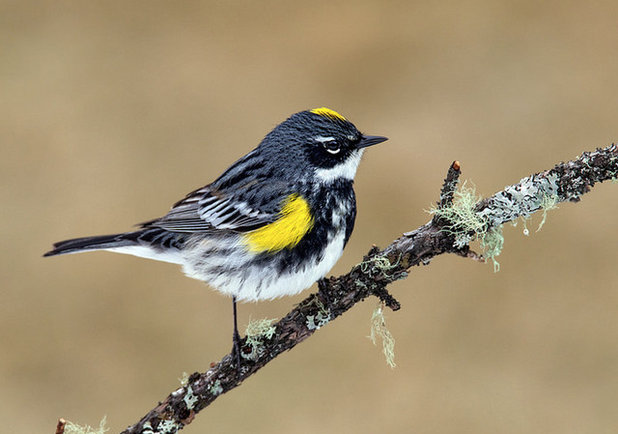
Nick Saunders
3. Yellow-Rumped WarblerWhere you’ll see them: In every U.S. state, including Alaska, at some point during the year
When to look: In southern states you should see them during the winter; they migrate to northern states in the East, Midwest and West for summer.
A vibrant patch of yellow feathers on the rump of both males and females makes yellow-rumped warblers stand out among native songbirds, and also gives these birds their name. While over 50 warbler species call North America home, the yellow-rumped warbler is the most common.
Growing a variety of native fruit- and seed-producing flowers, shrubs and trees in your yard will provide yellow-rumped warblers with the fuel they need during their winter migration. Native plants that support native insects will lure them back to your garden in summer.
Learn more about yellow-rumped warblers
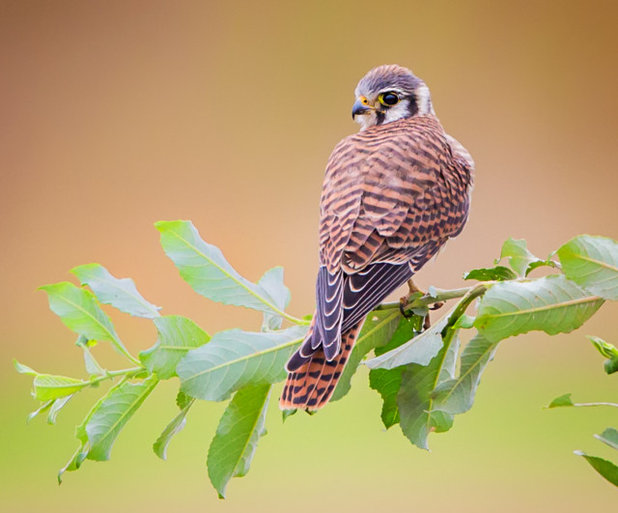
Dennis Davenport
4. American KestrelWhere you’ll see them: In many parts of North and South America
When to look: Year-round, though some spend summers in Canada and migrate to the southern U.S., Mexico or Central America for winter
These birds, the smallest falcons, hunt for invertebrates, small rodents and small birds in open, shrubby fields. Their coppery bodies and bluish-gray wings provide beautiful, stealthy drama.
Always on the lookout for a new location, kestrels prefer open woodlands and fields thick with native vegetation that will attract a variety of insects. If a kestrel ends up nesting near your house, you may be lucky enough to get some free rodent control.
Learn more about American kestrels
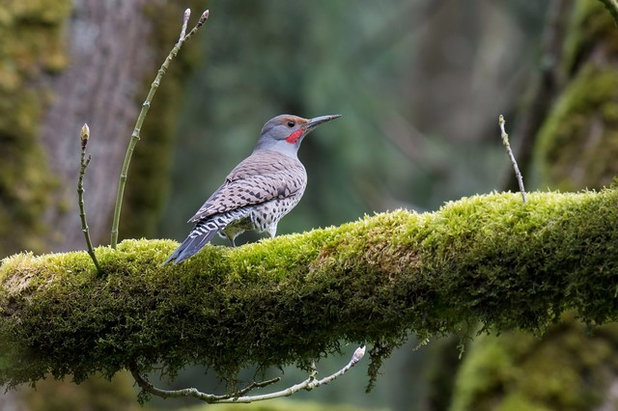
Gregory Lis
5. Northern FlickerWhere you’ll see them: Across the U.S. and Canada
When to look: Across the U.S. year-round and in Canada in the summer
These primarily ground-dwelling woodpeckers — yes, woodpeckers — are also known for their loud drumming, striking their beak on anything from a hollow tree and downed wood to a steel sign or tin roof. A bold flash of color on the undersides of their wings gives you a clue as to which type of flicker you’re seeing.
Northern flickers eat a mix of native berries and seeds, along with ants, beetles and other invertebrates, and nest in cavities created in dead tree trunks or large branches. They could benefit from efforts to provide habitat, reduce pesticide use and install nest boxes, as the U.S. Geological Survey reports that northern flicker populations are in decline.
Learn more about northern flickers
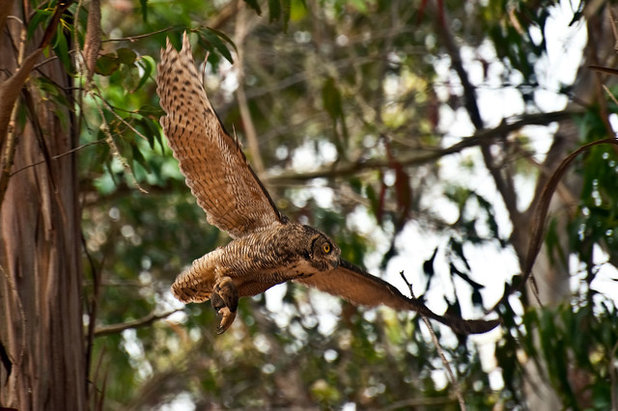 Photo by Anita Ritenour6. Great Horned OwlWhere you’ll see them:
Photo by Anita Ritenour6. Great Horned OwlWhere you’ll see them: Throughout North and Central America, including Canada, Alaska and Mexico. You’ll also see them in parts of South America.
When to look: Year-round, though they’re easier to find in winter during nesting
Perhaps more likely to be heard than seen, the great horned owl has a call that can be heard in both remote neighborhoods and city parks. You’ll know this nocturnal raptor when you see one, as its distinct feather tufts and stealthy flight set it apart from most backyard birds.
Great horned owls are hunters, so they’ll be looking for areas that provide them with prey and nesting habitat. They prefer to nest in trees, often reusing another bird’s nest, but will also rarely use a ledge or an owl box.
Learn more about the great horned owl
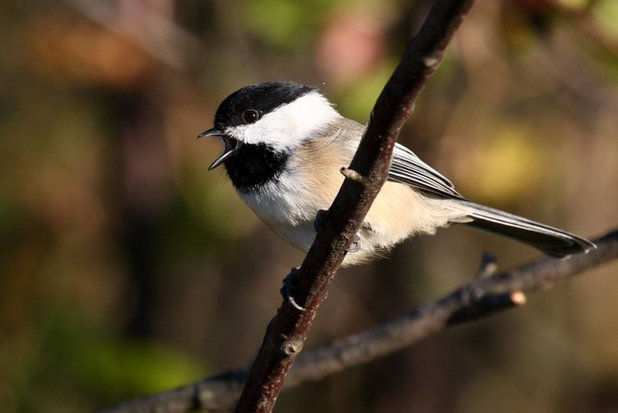 Photo by Tim Lenz7. ChickadeesWhere you’ll see them:
Photo by Tim Lenz7. ChickadeesWhere you’ll see them: Five native chickadee species inhabit most parts of the U.S.
When to look: Year-round
With their “chicka-dee” call and their quick, curious movements, chickadees sure are cute. Similar to one another in appearance but still distinct, black-capped chickadees,
Carolina chickadees,
mountain chickadees, boreal chickadees and
chestnut-backed chickadees inhabit trees and woody shrubs around the country. They make a home pretty much anywhere they can nest and find food and bird feeders.
These social songbirds subsist on a diet of insects and spiders in spring and early summer, turning to sunflower seeds, peanuts, suet, peanut butter and mealworms from bird feeders in winter. In fact, chickadees are some of the most common visitors to bird feeders; one study reported that they can visit one feeder more than 200 times in one day.
Learn more about chickadees
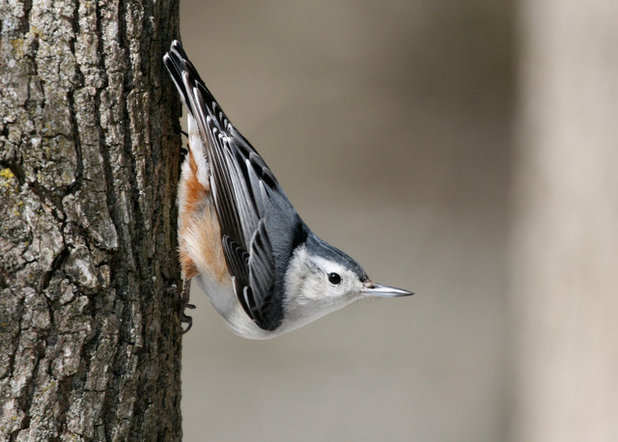 Photo by Matt MacGillivray8. Nuthatches Where you’ll see them:
Photo by Matt MacGillivray8. Nuthatches Where you’ll see them: Three native nuthatch species live across the U.S.
When to look: Year-round
Nuthatches, not to be confused with chickadees, are another small, chirpy songbird. One primary difference, as shown in this photo, is the nuthatch’s unusual mode of transit. While foraging for bugs and seeds, nuthatches like to walk down tree trunks, tail up and head down.
Nuthatches get their name from what they like to eat and how they like to eat it. They lodge nuts in a crack and then break, or “hatch,” the shell open with their bill. Native trees that attract insects in spring and produce seeds or nuts in fall are winners. In fall and winter, nuthatches might also search for seeds and nuts they have saved over the year for later.
Learn more about nuthatches
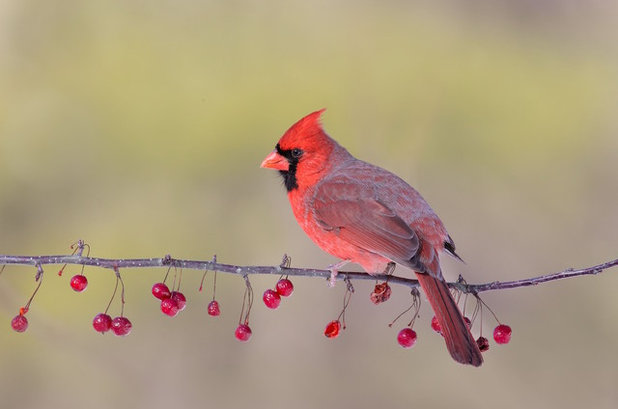
Dan Behm
9. Northern CardinalWhere you’ll see them: Prevalent in the eastern U.S., from Maine to Florida and west to Minnesota, Kansas, Oklahoma and Texas; some spread out to New Mexico and Arizona
When to look: Year-round
No bird stands out in the snowy winter landscape quite like the northern cardinal, its feather crest and crimson plumage glowing like a beacon. These colorful birds don’t migrate, instead frequenting gardens and chirping with delight year-round.
Cardinals eat a lot of seeds and fruit but will also forage on insects and larvae. Native trees, shrubs and flowers will attract these birds to your garden and provide the food resources they need.
Lear more about northern cardinals
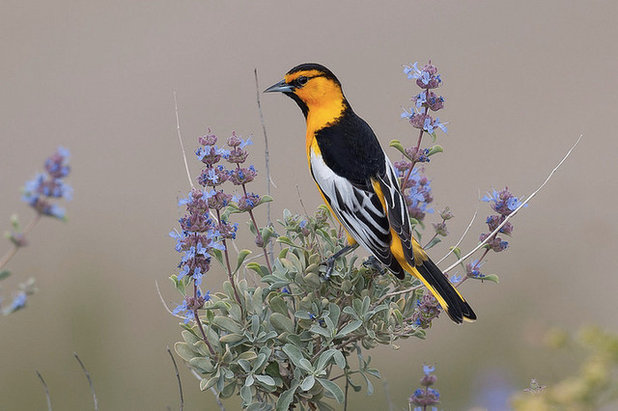
Gregory Lis
10. OriolesWhere you’ll see them: Throughout the U.S., depending on species
When to look: In the South starting in mid to late February before they slowly migrate north, arriving all the way north by March or April
The seasonal plumage of a breeding male oriole is pretty spectacular. Baltimore orioles
, Bullock’s orioles
, orchard orioles and hooded orioles, the most common North American native orioles, each showcase a unique take on the vivid gold-and-black feather combination, a reminder of the tropical locations where they spend their winters.
Plant native trees, shrubs and flowers to attract the native insects that orioles need to survive. Additionally, orioles like sweet fresh fruit and will happily snack on a cut orange.
Learn more about orioles
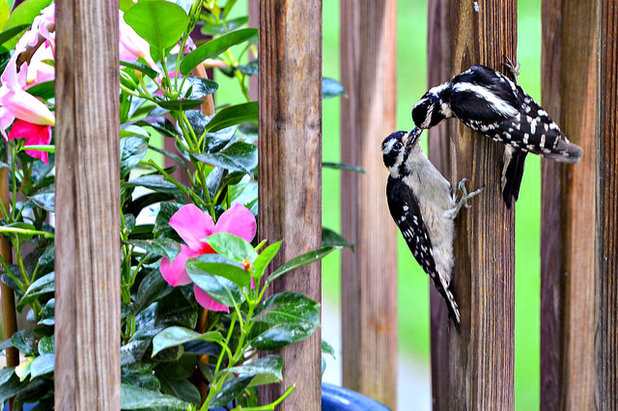
Blake Jacobs
11. WoodpeckersWhere you’ll see them: Everywhere in the U.S., except for small portions of the Southwest, southern Texas and Hawaii; also, depending on the species, you’ll see them as far south as Mexico and Central America and as far north as Alaska and parts of Canada
When to look: Year-round
Downy and hairy woodpeckers are the two most prevalent woodpeckers in North America, frequenting backyard bird feeders year-round. It’s hard distinguish between the two, as their coloration and actions are similar.
Drumming, and subsequent damage, on the sides of buildings can be an unfortunate nuisance. Patience and reflective streamers can go a long way, according to Cornell University research.
Learn more about woodpeckers
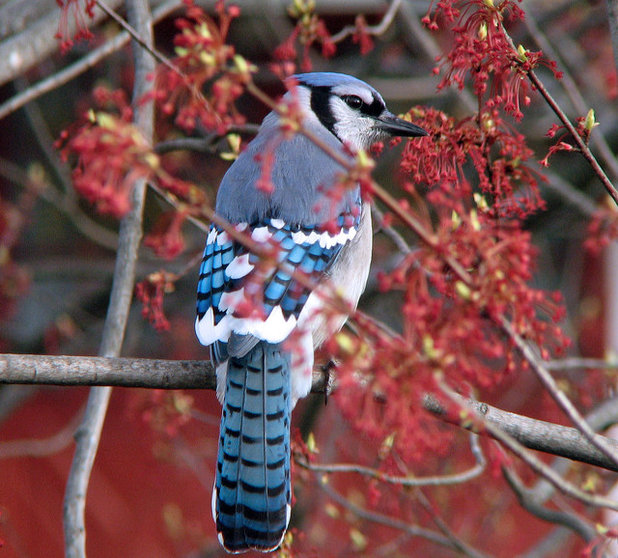 Photo by fishhawk
Photo by fishhawk
12. JaysWhere you’ll see them: While blue jays live primarily east of the Rocky Mountains; many species of jays live west of the Rockies.
When to look: Year-round, although they are more obvious in winter
Blue jays are the most common and widespread jay, and with their tufted feather crowns and distinct blue and white markings may be the most recognized. But bird-watchers across the country can keep their eyes peeled for their own backyard jays, including Steller’s jay, western scrub-jay and pinyon jay.
All jays love bird feeders. Fill yours with sunflower seeds or peanuts, or hang suet in cages. Oak trees that border large, open areas may also attract local jays.
Learn more about jays
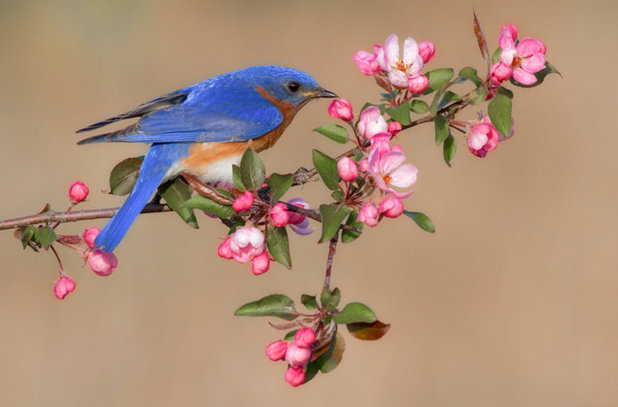
Philip Dunn
13. BluebirdsWhere you’ll see them: Throughout the U.S., Canada, Mexico and Central America, depending on the species and time of year
When to look: Year-round, depending on species and where you live
Eastern bluebird, western bluebird and mountain bluebird are the three species of bluebird that are native to North America, and each inhabits a distinct part of the country that its name suggests. All bluebird species are about the same size, and though each species has a distinct plumage pattern, all have the same beautiful blue on their crown, nape, back, wings and tail.
Bluebirds are facing habitat loss due to urbanization as well as aggressive, invasive birds. To welcome bluebirds into your backyard, plant berry-producing native trees and shrubs and consider installing a nest box.
Learn more about bluebirds





